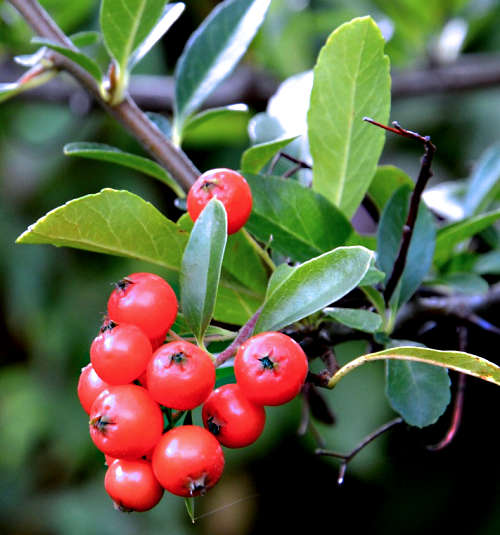Description
Form:
A dwarf shrub to a small tree with an upright, columnar, or weeping appearance.
Lifespan:
Up to 75 years for some varieties.
Leaf retention:
Evergreen.
Growth rate:
Moderate to rapid.
Mature Size:
Trees grow 10-20' (3-6m) high and 6-12' (1.8-3.8m) wide.
Dwarf shrubs grow to 3x3' (1x1m).
Flowers:
Four greenish-white petals, mildly fragrant, appear in clusters between the upper side
of a leaf stalk and its stem.
Male and female flowers grow on separate plants and both are needed for berries.
Bloom:
Early to mid-spring.
Fruit:
Red, orange, or yellow when ripe, 1/4" (6-7mm) diameter.
The mildly poisonous flesh covers four nutlets.
The fruit, commonly called berries although technically they are drupes, appear in
clusters on female plants in the fall and persist into winter.
Leaves:
Green, oval to elliptical, glossy and leathery, slightly toothed edges with a rounded tip.
No prickles.
The edible leaves contain the highest caffeine content of any North American plant and have
no tannins, making them less bitter when brewed as a tea.
They are also high in antioxidants, the theobromine of chocolate, and polyphenols and
flavonoids, which have demonstrated anti-inflammatory and anti-cancer properties.
Stems:
The plant has a multi-branched trunk covered with leaves.
Young stems are purple and turn grey or grey-white with age.
No thorns.
Dwarf cultivars develop very dense foliage.
The stems and leaves contain volatile oils and are more flammable than those of most plants.
Roots:
This plant produces a deep taproot and numerous lateral roots which anchor it well in
strong winds.
The roots are not aggressive and do not damage foundations or pipes.
They are tolerant of wet soils, and dry soils once established.
They produce suckers which are capable of producing a thicket.
Wildlife:
The flowers attract butterflies, pollinating insects and specialized bees.
The berries attract birds and small mammals.
Toxic / Danger:
The berries are mildly poisonous.
The leaves contain theobromine, a stimulate in chocolate that is toxic to cats, dogs, and
other animals.
Origin:
Southeastern United States, especially Gulf and Atlantic coasts from Texas to Virginia,
with isolated pockets in Mexico and Cuba.
According to archeological evidence, yaupon tea has been consumed for at least 8000 years.
Cultivation and Uses
USDA hardiness zones:
7-10a.
Heat tolerant:
Yes. Leaves may turn yellow-green in full sun in the hottest months of the year unless
deep watered every 7-14 days.
They will regain a darker green as temperatures cool.
Drought tolerant:
Yes, once established.
Sun:
Full to part sun.
Planting:
Locate in full sun to part shade, in moderately draining soil.
Part shade, such as afternoon shade, will keep the plant looking greener in summer.
Keep dwarf shrubs at least 10' (3m) and trees at least 20' from structures because
they are more flammable than most plants.
Dig a hole that is at least 1+1/2 times as wide as the root ball.
Shave off the outer layer of the root ball using a sharp knife and remove any roots that
are circling inside of the pot.
Fill the planting hole with water and let it drain, then position the root ball in the
hole so it is 1-2" (2.5-5cm) above soil level before refilling the hole with dirt.
Do not add soil amendments or fertilize at time of planting.
Water thoroughly.
Soil:
This plant is tolerant of soil types, including those which are acidic, alkaline, and
moderately saline.
A slow-release, balanced chemical or organic fertilizer applied mid-winter according to
package directions will speed growth.
Water after becoming established:
Deep water every 7-14 days in summer, and every 2-4 weeks in winter.
Mulch:
Apply organic mulch late winter to retain soil moisture.
Keep the mulch at least 4" (10cm) away from the trunk.
First Year Care:
Water every 2-3 days after planting.
After one week, start deep watering to develop a strong and deep root system to withstand
summer heat.
In fall, gradually reduce water frequency to once every 7-10 days, then every 2-3 weeks
in winter.
Prune:
Flowers develop on one year old wood.
Trimming the plant reduces or eliminates berries for the current year.
This plant takes pruning well and can be trimmed into a hedge.
Do not remove more than one-third of the canopy when trimming or picking leaves for tea.
The roots produce suckers which can be removed as soon as they appear.
Litter:
Low.
Propagation:
This plant can be grown from seed, cuttings, or transplanted root suckers.
Seed requires scarification and may remain dormant for 2-3 years before sprouting.
Cuttings are usually planted as semi-hardwood cuttings in the fall.
To propagate from root suckers, carefully remove the sucker so that it keeps its attached
roots.
Keep the soil moist to reduce transplant shock.
Uses:
Landscaping ornamental, screen, or hedge.
The young leaves can be picked anytime from any part of the plant, prepared, and
steeped in hot water to make a good tasting, caffeinated tea.
The caffeine is equal to that of green tea and about 60% of that of black tea.
The prepared tea leaves can be steeped to drink more than once, although the caffeine
will be depleted after the first use so the second steeping is 2% caffeine and third
steeping is decaffeinated tea.
To prepare the newly picked leaves for tea, spread them out to dry for several days,
then grind or shred them as desired, and further dry them in a low temperature oven.
Drying increases the solubility of caffeine in water.
Optionally, as a final step, the leaves can be oven or pan roasted at a higher temperature,
to achieve a light to dark roast.
Commercial teas are sold as green, or light, medium, or dark roasted.
The leaves were widely used as a caffeinated drink by native Americans before Europeans
arrived.
Comments
This plant is a member of the Holly family (Aquifoliaceae).
Unlike most holly plants, the leaves have no prickles.
When deep watered frequently in the first year to establish a strong root system, this
plant handles hot, dry climates with ease.
It is related to Ilex paraguariensis, known as Yerba Mate, a tree which grows in
the warm, humid, shady subtropical forests of Brazil, Argentina, Paraguay, and Uruguay.
The scientific name refers to a native American ceremony where the leaves were steeped
with ingredients from other plants, producing a drink that induced ritual vomiting.
Do you have additional information or a different experience for this plant that you would
like to share? Email info@GardenOracle.com. All contributions are welcome and appreciated.


